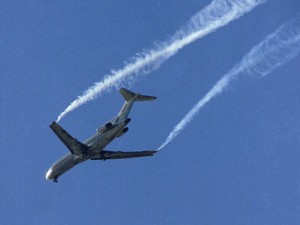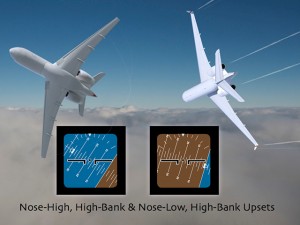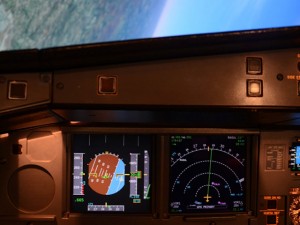By Paul BJ Ransbury, CEO at Aviation Performance Solutions (APS)
The discussion that follows considers the substantial risk associated with the use a live multi-engine business jet (as opposed to a ground-based simulator or all-attitude capable jet trainer) in the delivery of industry-compliant and comprehensive Upset Prevention and Recovery Training (UPRT). The discussion similarly applies to the majority of civil multi-engine piston, turboprop and turbojet airplanes.

If you fly a business jet, and are looking for upset training, it might seem that receiving training in a real aircraft that is similar to yours would provide the most relevant training. In order to assess any platform for this specialized area of training, we have to clearly understand the purpose of Upset Prevention and Recovery Training (UPRT) and what you ‘really need’ as a pilot to be adequately trained to improve safety.
Here are three ways UPRT helps pilots reduce their risk of a Loss of Control In-flight (LOC-I): 1) academic knowledge enhancement, 2) practical skill development that is positively transferrable to the pilot’s own model of airplane, and 3) specialized training to help pilots control the human factors elements that impair pilot’s abilities when confronted with an unexpected airplane upset. As academic information and associated knowledge expansion are generally independent of the type of training aircraft or platform used in a UPRT program, we will concentrate on the practical skill development and human factors contributions of UPRT which a business jet provides.
Why APS Does Not Use Business Jets in UPRT
In short, we don’t use business jet as they are expensive to operate and offer a very, very limited scope of training. That same limited scope of training can be completely addressed, and much more, as part of an integrated, full solution academic, on-aircraft piston, on-aircraft jet, and advanced simulator upset training program. Integration of these programs allows for overlay training to maximize the benefits of each training medium while minimizing the drawbacks, which results in thorough training that is highly effective for upset prevention and recovery skill development while creating a safe training environment and maximizing the value of the training.
History
Before coming to APS to experience the gold standard in UPRT, many pilots feel the best solution is being in an airplane that’s configured and equipped as close to their airplane as possible. In our experience, that’s not the case and 1000s of professional pilots graduating from APS UPRT programs testify of the appropriateness and power of the APS approach that transfers directly to their airplane.
Transferable Skills
The reason over 25,000 airlines pilots in major US legacy air careers flying every model of Boeing and Airbus fleets use the APS UPRT model is because it’s completely transferable to all transport category airplanes to include business jets. If business jets were the best training platform for UPRT, then we’d use them. We have them sitting on our ramp. They just aren’t and, in fact, the very opposite is the reality–a conclusion we base on being largest and most active UPRT provider in the world.
Four Critical Factors in UPRT Skill Development
The #1 factor for a pilot to be effective in an airplane crisis on it’s way to Loss of Control In-Flight (LOC-I) is for the pilot to an expert in overcoming Startle Factor. This simply can’t be done in a business jet or a simulator. The #2 factor is for the pilot to have the discipline to effectively apply recovery techniques in a startling environment to develop resilience which cannot be done to a sufficient level of fidelity in a business jet or simulator to be accessible in a real-world crisis. The #3 factor is repetition to proficiency and is addressed later in this article. And finally, yes, the #4 factor is transfer to, and application in, class of airplane that you fly day to day.
However, when #1, #2, and #3 are done properly and comprehensively, this best implementation of factor #4 is in an advanced simulator. The simulator adds the ‘absolutely critical’ ability to address these scenarios in the weather and at very low altitude which can’t be done in a business jet legally or safely either. Moreover, flight departments get a major benefit from them working together as a crew to address very real and challenging UPRT CRM concerns instead of having a safety pilot beside them as is required in business jet UPRT. Finally, if all four of these factors are addressed and trained comprehensively then there would be value in going up in a business jet to have that unique opportunity to apply recovery skills in the real world.
What UPRT Must Provide
The skills imparted through upset recovery are not skills that are acquired through normal pilot training. For the most part, today’s licensing training assumes that a stall will be prevented and that an upset will likely never occur beyond relatively benign limits. That is why classic licensing training is principally limited to recovery prior to a full aerodynamic stall. Commercial pilot applicants must recover from an “impending” stall, and Airline Transport Pilots must recover at the first indication of a stall which is typically the stall warning system indication such as shaker, light or aural warning. No training is required by the FAA beyond 30°of pitch or 60°of bank.
Beyond these boundaries are areas of the envelope with which pilots have little to no experience. Flight at, or even beyond, the critical angle of attack and in severe attitudes outside of normal flight operations are some of the areas where pilots must invest time to learn the essential upset recovery techniques. These particular techniques are often counter-intuitive. In addition, training in these areas facilitates important human factors training to improve their ability to correctly respond when faced with the in-flight upset event. Let’s look at some of the training a ‘live’ business jet aircraft can provide in these areas and the safety margins of operating such an aircraft in that domain.
Full Stall Training in Business Jets
Stalls are involved in over 40% of all LOC-I accidents in commercial aviation, and data released in 2015 shows that 46% of all fatalities in general aviation were LOC-I. In order to provide training to defeat the threat, stalls must be addressed completely and thoroughly. We have to understand that the type of stalls that are encountered in real-world accidents can often be very different from those encountered in licensing training, and today’s simulators — even forthcoming extended envelope simulators — cannot always replicate the variety of accelerations in g, decelerations in airspeed, and presence of sideslip which can be encountered in actual flight.
Can a multi-engine airplane certified under Part 23 or Part 25 be used to safely experience the full range of stall characteristics and behavior with which a pilot must become familiar in order to reduce the threat of LOC-I? In a word “no.” And reputable UPRT providers, even those addressing some portion of their training in a business jet, agree with this assessment and use other training platforms to address these deficiencies to varying levels of comprehension. Some organizations that use business jets in their training courses integrate professional test pilots as instructors. These instructors are generally happy to discuss the safety margins and/or additional flight testing they’ve conducted on their airplane(s) to provide a safe training environment.

The recipe for a spin is a stall with enough sideslip or yaw present long enough to initiate auto-rotation. Even if intentional spins are not a part of a UPRT program, training in accelerated and cross-controlled stalls (such as a multi-engine aircraft could experience with differential thrust or an engine out in a stall), should be a part of any comprehensive UPRT course. By certification, all single-engine normal category aircraft must be recoverable from a one-turn spin, with a few exceptions for spin resistant aircraft. Some utility category and all aerobatic category airplanes have flight tested margins of safety up to six turns in a spin before initiating proper spin recovery technique. On the other hand, no multi-engine civil aircraft must demonstrate the ability to recover from even a one-turn spin. In creating the flight conditions necessary for pilots to develop essential upset recovery knowledge and skills, there are many dynamic situations which occur which do not provide the controlled conditions present in multi-engine certification flight testing by professional test pilots.
The use of a business jet to provide UPRT can result in one of two situations or a combination of both. First, either the full spectrum of required prevention and recovery skills cannot be provided in that platform. Or, second, the margin of safety will be less than when such training is delivered in an aircraft certified for recovery from spins. Single engine normal category aircraft that are not approved for intentional spins must still be recoverable from a one-turn spin. As addressed in FAA Advisory Circular 61-67C – Stall and Spin Awareness Training – section 400, subpart a), the reason for the one turn spin testing is to assure a margin of safety for full stalls conducted in the training environment where stall recovery could be delayed. For the multi-engine business jet aircraft, there is no such expanded margin of safety due to delayed, incorrect or prolonged stall recovery, or an inadvertent spin entry as might occur by an inexperienced pilot developing comprehensive UPRT skills.
Stall situations conducted in the training environment can be more dynamic with wider variables than found in the flight testing of multi-engine airplanes. To provide the broadest margin of safety, full stall training for UPRT should be conducted in utility and aerobatic category airplanes that have been approved for intentional spins. Then, the full range of stall progression from the stall, to uncoordinated stall, to the incipient spin, and finally on to the fully developed spin, as well as other aggravating factors, can be demonstrated and understood in a training environment with demonstrable margins of safety.
The International Air Transport Association (IATA), in their Guidance and Best Practices for the Implementation of Upset Prevention and Recovery Training, section 12.3.1 on Training Airplanes, states, “Normal or Utility category aeroplanes (certified to ≤60 or ≤90deg bank) are not suitable to achieve the complete human-factor training outcome and can only provide part of the desired outcome. Technically and operationally, the use of Normal or Utility category aircraft for on-aeroplane UPRT may create substantial safety risks, depending on the training maneuvers.” Single-engine airplanes certified in the aerobatic category are the recommended on-aircraft UPRT platform by IATA.
Cost-Benefit Analysis: Business Jet vs. All-Attitude Jet Trainer
APS has conclusively demonstrated that initial UPRT training for professional pilots requires a minimum of four separate and distinct flights of approximately 40-minutes ‘all-attitude all-envelope maneuvering’ in each, along with relevant keep-it-simple academic training, over a period of three days for optimum results. In our experience as the most active UPRT organization in the world directly training nearly 2000 professional pilots annually and over 25,000 airline pilots each year through APS-Certified UPRT programs, we have a deep understanding of today’s pilot needs. To be clear, exposure training to impress pilots with the perception that they’ve had training of value can be done in one or two flights. However, to have tangible, accessible skills and disciplines to actually mitigate the onset of a loss of control in-flight condition in the real world takes more. A lot more. So what’s the cost? If it’s agreed, for the purposes of this discussion, that APS, the world leader in UPRT, is correct, then you need four flights over three days. For clarity, that’s not 1 x 4-hour flight or 2 x 2-hour flights — it’s 4 x 1-hour flights of which each one has no more than 40-minutes of dedicated all-attitude all-envelope UPRT.
APS has 4-flight programs — each having the option of being augmented with all-weather, low altitude, advanced simulator sessions that can’t be done safely in any real airplane. The entire program can be done in an all-attitude, sweptwing, glass cockpit, IFR-certified, high altitude-capable, jet trainer that can address the full range of on-aircraft UPRT as specified by ICAO in the ICAO Manual on Airplane Upset Prevention and Recovery Training, the industry’s most comprehensive resource. Keep in mind that APS is not financially limited in its selection of training assets. We acquire the best instructors, airplanes (both piston and jet), and advanced simulators (Level D, extended envelope, and fixed base) to impart the very best training value. Unfortunately, in our professional opinion, the cost-benefit analysis concerning the use of business jets in UPRT verifies that the business jet is the lowest value per dollar, especially during initial training, compared to the all-attitude jet and even the all-attitude piston airplane when each of these assets are under the guidance of a uniquely qualified and trained, expert UPRT instructor.
Defending Business Jet Stall Training
Although Part 25 or multi-engine Part 23 business jet does not require spin testing to establish robust margins of safety beyond the aerodynamic stall as do single engine Part 23 airplanes, in some cases – such as when there is no definitive ‘g break’, deterrent buffet or uncontrollable roll-off to signal the first characteristic of a full stall, the stick/yoke must remain on the aft stop for two seconds. During flight test, however, only one of these stall characteristics is technically necessary to indicate the full stall occurrence and subsequent recoverability to meet certification requirements. Meaning, the ‘two second aft stick’ characteristic may or may not apply to some models of multi-engine airplanes. However, there are aspects of the multi-engine business jet design on some models which do add to the margin of safety near the stall such as redundant stall warning systems and high lift devices (slats, slotted flaps, etc.) that are not typically found in the single-engine Part 23 airplanes. It is relevant to consider that the stall characteristics assessed in the flight testing of multi-engine airplanes do address other than 1-g stall entries across a wide range of altitude, weight, CG, and aircraft configurations.
Some multi-engine jet airplanes, like Hawkers, have published procedures for conducting stall training in the airplane. However, one critical consideration is whether or not the UPRT-required stall entries such as accelerated full stall entries and uncoordinated full stalls are contemplated within the scope and intent of those published stall training procedures. If not, it is important to determine what safety margins, if any, remain that allow that platform to be used to meet the awareness, knowledge and skill development needs of the associated UPRT-specific exercises or scenarios. In any case, and in any airplane, the conditions, safety margins, and stall/spin-relevant experience and currency levels of all pilot crew members must be considered very carefully.
Maneuvering Limitations in Business Jets

While averting negative training or negative transfer of skill, a critical element of UPRT is the transition from the normal operations envelope into the all-attitude, all-envelope environment and back again. This is required to practice the counter-intuitive skills and techniques not taught as a part of operating an aircraft in its normal envelope. A training aircraft should have no pitch and bank limitations because in an actual airplane upset, virtually any attitude could be encountered. There are several requirements which come along with these operational demands such as the ability to wear the parachutes required beyond 30°of pitch and 60°of bank. The point of having a parachute as a safety mitigation tool is violated if there is no ability for timely egress, which typical business jets are not equipped for in flight. In these cases, where training is intentionally conducted in these regions, the operator requires a Letter of Deviation Authority (LODA) from the FAA. Of importance, even with a LODA, is the operator demonstrating definitive margins of safety for each maneuver being conducted to both regulators and customers alike.
The maneuvering required to develop important UPRT skills demands aircraft structural limits which will provide the necessary margin of safety. While UPRT for pilots of transport category aircraft should be restricted to the limit loads of their aircraft, the load exceedances typically seen in UPRT, especially during initial training sessions, must be accounted for when pilots in training sometimes inadvertently exceed normal category limits and often exceed transport category load limits. Structural fatigue should also be a consideration for aircraft dedicated to the delivery of UPRT.
Although the initial impression of using a business jet to deliver UPRT to business jet pilots seems appropriate, we can see from the reasons listed above that typical business jet aircraft have limits which impact training effectiveness in areas crucial to UPRT and can have reduced margins of safety in areas of aerodynamic and structural consideration.
Industry Recommendations

Despite the considerations presented above, there are valid reasons for wanting to experience UPRT in a business jet aircraft. However, the increased control forces, decreased control response, and limited field of view in comparison to many all-attitude capable training aircraft can be compensated for in other ways. ICAO, in its Manual on Aeroplane Upset Prevention and Recovery Training (ICAO UPRT Manual), calls for the use of flight simulation in concert with on-aircraft training such as experienced in the APS Jet Pilot Integrated Upset Training program. This “Integrated Approach” provides the highest overall training effectiveness and margins of safety in the delivery of UPRT. There may be value in adding a flight in a business jet after completing the Integrated UPRT Approach to experience certain aspects of UPRT that can be safely and effectively accomplished in that platform.
The ICAO UPRT Manual (Doc 10011) in Section 3.3.1.7, when referencing on-aircraft training, states, “On-aeroplane UPRT is not intended to be delivered while operating transport category aeroplanes or aeroplanes requiring two or more crew members; for those operations, UPRT should not be permitted to be conducted outside the confines of a suitable FSTD (Flight Simulator Training Device).”
APS Position on Using Real Business Jets in Upset Training
In closing, APS firmly believes the integration of advanced business jet simulators and transport category simulators can be powerful training resources when used within an integrated academic, on-aircraft and simulator training program per ICAO and IATA. There certainly can be some value in using a real business jet in UPRT, although it is very important to consider safety margins, the comprehensiveness of the training being conducted compared to ICAO UPRT requirements, integration with more maneuvering-capable airplanes, and the extent to which the overall UPRT program is delivered in the business jet. All said and done, the type of platform used for UPRT certainly matters but the most critical factor by far in the effective and comprehensive delivery of UPRT is the expert instructor. Best of success and be safe.
Please take a moment to review the following links:




Comments: